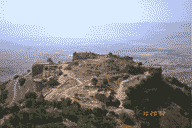
Known to the Arabs as Subebe and to the Crusaders as L'Asibebe, Nimrod's Fortress is the popular name by which one of Israel's largest Crusader fortresses is known.
It is named for Nimrod, a mythical character of legendary strength.
As the Crusader Kingdom expanded northward from Jerusalem to the Hulah Valley, the Moslems responded by fortifying Banias. Even so, in 1129, the Ismaelites betrayed their Damascene masters and handed the keys of the city and its fortress over to the Crusaders. The fortress was retaken by the Moslems in 1132, but in 1139 the Crusaders once again captured it.
In 1156, as the Crusaders mobilized their forces for an attack on Ashkelon in the south, the Moslems mobilized their own forces and wrested control of Banias and the fortress, which never again passed into Crusader hands.
In the first half of the thirteenth century, the fortress was refortified by sultans of the Ayyub Dynasty. Ten Arabic inscriptions bear witness to their activities, and most of the remains visible in the area today are from this period.
By 1260, the Mameluke sultan Baybars gained control of the fortress. He constructed a citadel built of giant stones and decorated with inscriptions. From the fourteenth through the sixteenth centuries, the fortress served as a jail for political prisoners of the Damascus government. Thereafter, the fortress was abandoned, to be used only by local farmers as sheepfolds and cowsheds for their livestock.
The National Parks Authority, in coordination with the Department of Antiquities and Museums and with the participation of the Golan Regional Council and the Government Tourist Corporation, have carried out extensive conservation work at the site. A footpath has been cut, and restrooms and a parking lot installed.